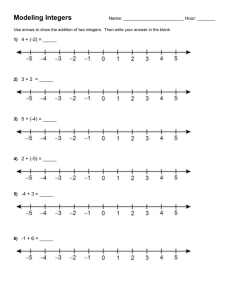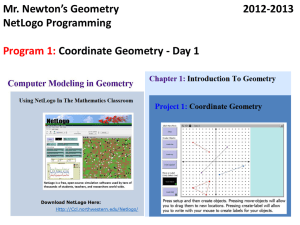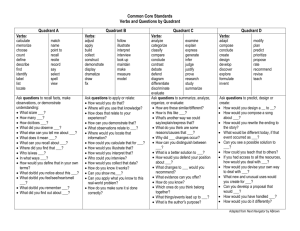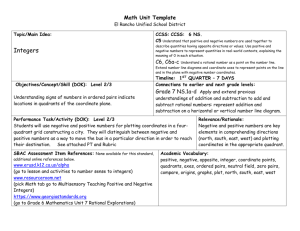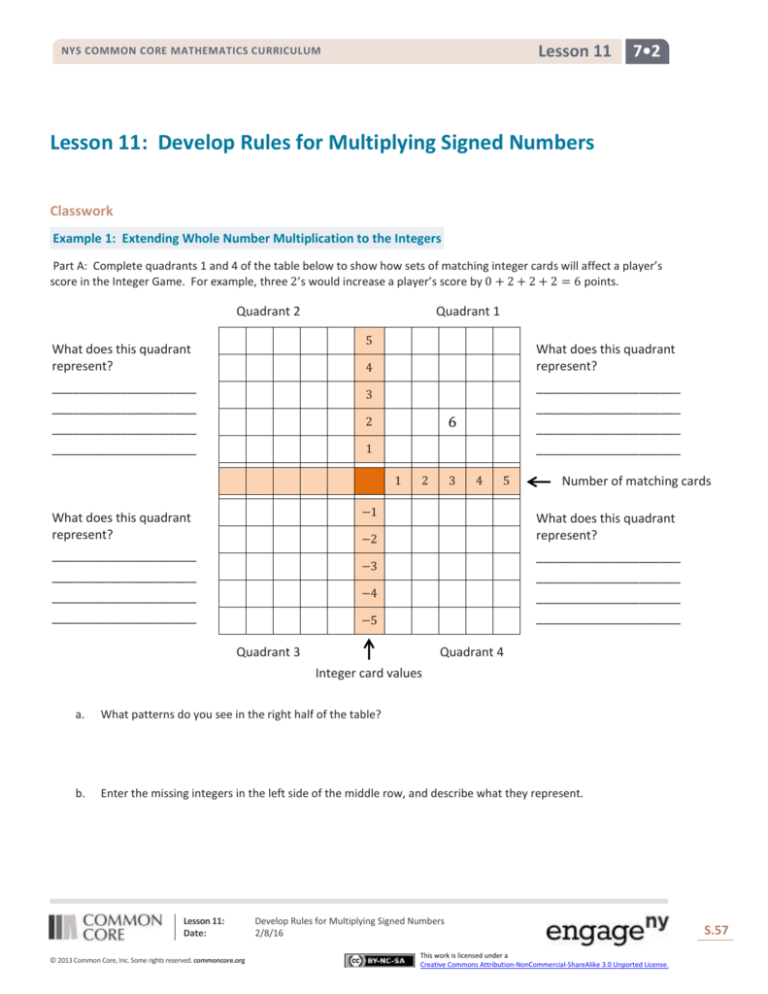
Lesson 11
NYS COMMON CORE MATHEMATICS CURRICULUM
7•2
Lesson 11: Develop Rules for Multiplying Signed Numbers
Classwork
Example 1: Extending Whole Number Multiplication to the Integers
Part A: Complete quadrants 1 and 4 of the table below to show how sets of matching integer cards will affect a player’s
score in the Integer Game. For example, three 2’s would increase a player’s score by 0 + 2 + 2 + 2 = 6 points.
Quadrant 2
Quadrant 1
5
What does this quadrant
represent?
_____________________
_____________________
_____________________
_____________________
What does this quadrant
represent?
_____________________
_____________________
_____________________
_____________________
4
3
6
2
1
1
2
3
4
5
−1
What does this quadrant
represent?
_____________________
_____________________
_____________________
_____________________
Number of matching cards
What does this quadrant
represent?
_____________________
_____________________
_____________________
_____________________
−2
−3
−4
−5
Quadrant 3
Quadrant 4
Integer card values
a.
What patterns do you see in the right half of the table?
b.
Enter the missing integers in the left side of the middle row, and describe what they represent.
Lesson 11:
Date:
© 2013 Common Core, Inc. Some rights reserved. commoncore.org
Develop Rules for Multiplying Signed Numbers
2/8/16
S.57
This work is licensed under a
Creative Commons Attribution-NonCommercial-ShareAlike 3.0 Unported License.
57
Lesson 11
NYS COMMON CORE MATHEMATICS CURRICULUM
7•2
Part B: Complete quadrant 2 of the table.
c.
What relationships or patterns do you notice between the produtcs (values) in quadrant two and the products
(values) in quadrant 1?
d.
What relationships or patterns do you notice between the products (values) in quadrant two and the products
(values) in quadrant four?
e.
Use what you know about the products (values) in quadrant one, two, and four to describe what quadrant
three will look like when its products (values) are entered.
Part C: Complete the quadrant 3 of the table.
Refer to the completed table to help you answer the following questions:
f.
Is it possible to know the sign of a product of two integers just by knowing in which quadrant each integer is
located? Explain.
g.
Which quadrants contain which values? Describe an integer game scenario represented in each quadrant.
Lesson 11:
Date:
© 2013 Common Core, Inc. Some rights reserved. commoncore.org
Develop Rules for Multiplying Signed Numbers
2/8/16
S.58
This work is licensed under a
Creative Commons Attribution-NonCommercial-ShareAlike 3.0 Unported License.
58
Lesson 11
NYS COMMON CORE MATHEMATICS CURRICULUM
7•2
Example 2: Using Properties of Arithmetic to Explain Multiplication of Negative Numbers
Exercise 1: Multiplication of Integers in the Real-World
Generate real-world situations that can be modeled by each of the following multiplication problems. Use the Integer
Game as a resource.
a.
−3 × 5
b.
−6 × (−3)
c.
4 × (−7)
Lesson 11:
Date:
© 2013 Common Core, Inc. Some rights reserved. commoncore.org
Develop Rules for Multiplying Signed Numbers
2/8/16
S.59
This work is licensed under a
Creative Commons Attribution-NonCommercial-ShareAlike 3.0 Unported License.
59
Lesson 11
NYS COMMON CORE MATHEMATICS CURRICULUM
7•2
Lesson Summary
To multiply signed numbers, multiply the absolute values to get the absolute value of the product. The sign of the
product is positive if the factors have the same sign and negative if they have opposite signs.
Problem Set
1.
Complete the problems below; then, answer the question that follows.
𝟑× 𝟑 =
𝟑×𝟐 =
𝟑×𝟏 =
𝟑×𝟎 =
𝟑 × (−𝟏) =
𝟑 × (−𝟐) =
𝟐×𝟑 =
𝟐×𝟐 =
𝟐×𝟏 =
𝟐×𝟎 =
𝟐 × (−𝟏) =
𝟐 × (−𝟐) =
𝟏×𝟑 =
𝟏×𝟐 =
𝟏×𝟏 =
𝟏×𝟎 =
𝟏 × (−𝟏) =
𝟏 × (−𝟐) =
𝟎×𝟑=
𝟎×𝟐 =
𝟎×𝟏 =
𝟎×𝟎 =
𝟎 × (−𝟏) =
𝟎 × (−𝟐) =
−𝟏 × 𝟑 =
−𝟏 × 𝟐 =
−𝟏 × 𝟏 =
−𝟏 × 𝟎 =
−𝟏 × (−𝟏) =
−𝟏 × (−𝟐) =
−𝟐 × 𝟑 =
−𝟐 × 𝟐 =
−𝟐 × 𝟏 =
−𝟐 × 𝟎 =
−𝟐 × (−𝟏) =
−𝟐 × (−𝟐) =
−𝟑 × 𝟑 =
−𝟑 × 𝟐 =
−𝟑 × 𝟏 =
−𝟑 × 𝟎 =
−𝟑 × (−𝟏) =
−𝟑 × (−𝟐) =
Which row shows the same pattern as the outlined column? Are the problems similar or different? Explain.
2.
Explain why (−4) × (−5) = 20. Use patterns, an example from the Integer Game, or the properties of operations
to support your reasoning.
3.
Each time that Samantha rides the commuter train, she spends $4 for her fare. Write an integer that represents the
change in Samantha’s money from riding the commuter train to and from work for 13 days.
4.
Write a real-world problem that can be modeled by 4 × (−7).
Enrichment
5.
Use properties to explain why for each integer 𝑎, −𝑎 = −1 × 𝑎. (Hint: What does (1 + (−1)) × 𝑎 equal? What is
the additive inverse of 𝑎?)
Lesson 11:
Date:
© 2013 Common Core, Inc. Some rights reserved. commoncore.org
Develop Rules for Multiplying Signed Numbers
2/8/16
S.60
This work is licensed under a
Creative Commons Attribution-NonCommercial-ShareAlike 3.0 Unported License.
60

